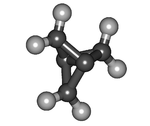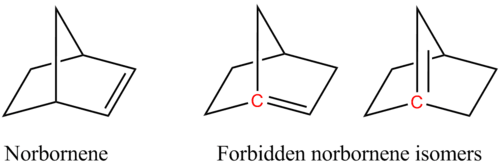Ring strain
In organic chemistry, ring strain is a type of instability that exists when bonds in a molecule form angles that are abnormal. Strain is most commonly discussed for small rings such as cyclopropanes and cyclobutanes, whose internal angles are substantially smaller than the idealized value of approximately 109°. Because of their high strain, the heat of combustion for these small rings is elevated.[1][2]
Ring strain results from a combination of angle strain, conformational strain or Pitzer strain (torsional eclipsing interactions), and transannular strain, also known as van der Waals strain or Prelog strain. The simplest examples of angle strain are small cycloalkanes such as cyclopropane and cyclobutane.

Angle strain (Baeyer strain)
Alkanes
In alkanes, optimum overlap of atomic orbitals is achieved at 109.5°. The most common cyclic compounds have five or six carbons in their ring.[3] Adolf von Baeyer received a Nobel Prize in 1905 for the discovery of the Baeyer strain theory, which was an explanation of the relative stabilities of cyclic molecules in 1885.[3]
Angle strain occurs when bond angles deviate from the ideal bond angles to achieve maximum bond strength in a specific chemical conformation. Angle strain typically affects cyclic molecules, which lack the flexibility of acyclic molecules.
Angle strain destabilizes a molecule, as manifested in higher reactivity and elevated heat of combustion. Maximum bond strength results from effective overlap of atomic orbitals in a chemical bond. A quantitative measure for angle strain is strain energy. Angle strain and torsional strain combine to create ring strain that affects cyclic molecules.[3]
- CnH2n + 3/2nO2 → nCO2 + nH2O − ΔHcombustion
Normalized energies that allow comparison of ring strains are obtained by measuring per methylene group (CH2) of the molar heat of combustion in the cycloalkanes.[3]
- ΔHcombustion per CH2 − 658.6 kJ = strain per CH2
The value 658.6 kJ per mole is obtained from an unstrained long-chain alkane.[3]
| Ring size | Strain energy (kcal/mol) | Ring size | Strain energy (kcal/mol) | |
|---|---|---|---|---|
| 3 | 27.5 | 10 | 12.4 | |
| 4 | 26.3 | 11 | 11.3 | |
| 5 | 6.2 | 12 | 4.1 | |
| 6 | 0.1 | 13 | 5.2 | |
| 7 | 6.2 | 14 | 1.9 | |
| 8 | 9.7 | 15 | 1.9 | |
| 9 | 12.6 | 16 | 2.0 |
Angle strain in alkenes
Cyclic alkenes are subject to strain resulting from distortion of the sp2-hybridized carbon centers. Illustrative is C60 where the carbon centres are pyramidalized. This distortion enhances the reactivity of this molecule. Angle strain also is the basis of Bredt's rule which dictates that bridgehead carbon centers are not incorporated in alkenes because the resulting alkene would be subject to extreme angle strain.

Examples
In cycloalkanes, each carbon is bonded nonpolar covalently to two carbons and two hydrogen. The carbons have sp3 hybrization and should have ideal bond angles of 109.5°. Due to the limitations of cyclic structure, however, the ideal angle is only achieved in a six carbon ring — cyclohexane in chair conformation. For other cycloalkanes, the bond angles deviate from ideal.
Molecules with a high amount of ring strain consist of three, four, and some five-membered rings, including: cyclopropanes, cyclopropenes, cyclobutanes, cyclobutenes, [1,1,1]propellanes, [2,2,2]propellanes, epoxides, aziridines, cyclopentenes, and norbornenes. These molecules have bond angles between ring atoms which are more acute than the optimal tetrahedral (109.5°) and trigonal planar (120°) bond angles required by their respective sp3 and sp2 bonds. Because of the smaller bond angles, the bonds have higher energy and adopt more p-character to reduce the energy of the bonds. In addition, the ring structures of cyclopropanes/enes and cyclclobutanes/enes offer very little conformational flexibility. Thus, the substituents of ring atoms exist in an eclipsed conformation in cyclopropanes and between gauche and eclipsed in cyclobutanes, contributing to higher ring strain energy in the form of Van der Waals repulsion.
- cyclopropane, C3H6 — the C-C-C bond angles are 60° whereas tetrahedral 109.5° bond angles are expected.[4] The intense angle strain leads to nonlinear orbital overlap of its sp3 orbitals.[3] Because of the bond's instability, cyclopropane is more reactive than other alkanes.[3] Since any three points make a plane and cyclopropane has only three carbons, cyclopropane is planar.[4] The H-C-H bond angle is 115° whereas 106° is expected as in the CH2 groups of propane.[4]
- cyclobutane, C4H8 — if it was completely square planar its bond angles would be 90° whereas tetrahedral 109.5° bond angles are expected.[3] However, the actual C-C-C bond angle is 88° because it has a slightly folded form to relieve some torsional strain at the expense of slightly more angle strain.[3] The high strain energy of cyclobutane is primarily from angle strain.[4]
- cyclopentane, C5H10 — if it was a completely regular planar pentagon its bond angles would be 108°, but tetrahedral 109.5° bond angles are expected.[3] However, it has an unfixed puckered shape that undulates up and down.[3]
- cyclohexane, C6H12 — Although the chair conformation is able to achieve ideal angles, the unstable half-chair conformation has angle strain in the C-C-C angles which range from 109.86° to 119.07°.[5]
- ethylene oxide, CH2OCH2
- cubane, C8H8
Ring strain can be considerably higher in bicyclic systems. For example, bicyclobutane, C4H6, is noted for being one of the most strained compounds that is isolatable on a large scale; its strain energy is estimated at 63.9 kcal mol−1 (267 kJ mol−1).[6][7]
Application
The potential energy and unique bonding structure contained in the bonds of molecules with ring strain can be used to drive reactions in organic synthesis. Examples of such reactions are Ring opening metathesis polymerisation, photo-induced ring opening of cyclobutenes, and nucleophilic ring-opening of epoxides and aziridines.
See also
References
- Smith, Michael B.; March, Jerry (2007), Advanced Organic Chemistry: Reactions, Mechanisms, and Structure (6th ed.), New York: Wiley-Interscience, ISBN 978-0-471-72091-1
- Wiberg, K. (1986). "The Concept of Strain in Organic Chemistry". Angew. Chem. Int. Ed. Engl. 25 (4): 312–322. doi:10.1002/anie.198603121.
- Wade, L. G. "Structure and Stereochemistry of Alkanes." Organic Chemistry. 6th ed. Upper Saddle River, NJ: Pearson Prentice Hall, 2006. 103-122. Print.
- Anslyn, Eric V., and Dennis A. Dougherty. "Chapter 2: Strain and Stability." Modern Physical Organic Chemistry. Sausalito, CA: University Science, 2006. 100-09. Print.
- http://wetche.cmbi.ru.nl/organic/cyclohexane/jm/exer3.html
- Wiberg, K. B. (1968). "Small Ring Bicyclo[n.m.0]alkanes". In Hart, H.; Karabatsos, G. J. (eds.). Advances in Alicyclic Chemistry. 2. Academic Press. pp. 185–254. ISBN 9781483224213.
- Wiberg, K. B.; Lampman, G. M.; Ciula, R. P.; Connor, D. S.; Schertler, P.; Lavanish, J. (1965). "Bicyclo[1.1.0]butane". Tetrahedron. 21 (10): 2749–2769. doi:10.1016/S0040-4020(01)98361-9.